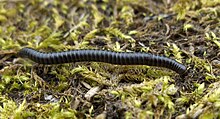多足類
| 多足亞門 Myriapoda 化石时期:志留紀至今
| |
|---|---|

| |
| 歐洲蜈蚣(Lithobius forficatus) | |
| 科学分类 | |
| 界: | 动物界 Animalia |
| 门: | 节肢动物门 Arthropoda |
| 演化支: | 有颚类 Mandibulata |
| 亚门: | 多足亞門 Myriapoda |
| 綱 [1] | |
多足亞門(或稱多足類、多足綱,學名:Myriapoda,来自古希腊语μυριάς一万和 πούς脚、腿),是節肢動物門下的一类,包含了馬陸及蜈蚣等。多足類有超過13000個物種,都是陸生動物。[2]雖然學名Myriapoda的词源是一萬条腿,但實際上多足类最多只有約1300条腿(冥后真千足蟲,Eumillipes persephone),少至10隻以下。牠們的頭部有一對觸角,部分種類有單眼。身體細長且分為多節,除了倍足綱(馬陸)外每一節只有一對腳,而馬陸的身體每一節上都有兩對腳。
多足類大多棲息在濕潤的森林中,也有少部份多足類棲息在草原、半乾旱地區或甚至是沙漠之中。[3]少足綱及綜合綱都是相當微小的生物,主要生活在土壤中。大部份多足類生物都是植食性的,以腐敗的植物為主食,在分解植物的遺體上扮演重要的角色[2],只有唇足綱(蜈蚣和蚰蜒)是夜行性的掠食者。
雖然普遍認為,多足類對人類沒有危害,但許多多足類生物會分泌有毒的物質(一般包含醌),並在皮膚上造成短暫的水泡及變色。[4]
雖然多足類的外殼薄且脆弱,不利於形成化石,但仍有相當多的化石證據,顯示多足類是一類很古老的生物。出現在寒武紀的單肢動物化石,具有類似多足生物的型態;而已確認最早的多足類化石,則出土於志留紀晚期的地層。最早的蜈蚣化石出土於泥盆紀地層,顯示多足類的型態在泥盆紀之前,已經開始出現變化[2]。若以核糖體序列分歧的程度來推算,多足類生物的分歧始於泥盆紀。[5]
多足類物種不全都是害蟲;唇足綱之下的蚰蜒目物種皆為捕食居家害蟲的益蟲。
分類
[编辑]就節肢動物門中哪個類群的親緣關係與多足亞門最為接近的議題,一直存在著爭議。根據有顎類假說,多足類是泛甲殼動物(包含甲殼亞門及六足亞門的演化支)的姊妹群;若根據缺角類(Atelocerata)假說,六足类与多足类最為接近,两者共同组成单肢类(Uniramia);若根據奇足類(Paradoxopoda,又名多足螯肢類)假說,螯肢亞門則是最接近多足類的節肢動物類群。最後的假說雖然只有少數形態特徵的證據支持,但卻有大量分子生物學研究結果支持。[6]
目前多足類之下分有四個綱.分別是唇足綱、倍足綱、少足綱及綜合綱,共包含約12000個物種。[7]儘管一般認為多足類的每一綱同屬一個單源群,但它們之間的演化關係卻還不明確。[8]
唇足綱
[编辑]
唇足綱主要包括蜈蚣及蚰蜒。牠們第一體節的步足特化成唇足綱特有的顎足,可注射毒液至獵物體內或用於防禦。牠們行動很快速,是夜行性的掠食者。牠們約有3300個物種[7],型態多樣,從最小的Nannarup hoffmani(只有12毫米長)[9]到巨大的加拉巴戈巨人蜈蚣(Scolopendra galapagoensis,超過40厘米長)。
倍足綱
[编辑]
倍足綱物種通稱馬陸。大部分馬陸行動都較唇足綱慢,主要以枯葉及腐植質為食。牠們的特徵是身體的每一節有兩對腳。目前被記錄的倍足綱動物約有8000多種,但這個數字與全世界實際的多樣性相比,大約只有十分之一;也就是說至少還有63000種倍足綱生物有待發現。[7]冥后真千足蟲(Eumillipes persephone)是目前已知擁有最多腳的马陆,大約有1300隻。球馬陸身體較短,在遭受干擾時可以像球鼠婦科般將身體卷成球狀進行防禦。
少足綱
[编辑]
少足綱是一類數量及體型上都較小的多足類。牠們一般只有0.5-2.0厘米長,除了南極洲以外,在全世界所有大洲的土壤中都可見。[10]牠們共有超過700個物種。[7]一般認為牠們是倍足綱的姊妹分類群:牠們的身體分節,在節與節之間有融合了的背板,有點類似倍足綱生物,只不過倍足綱生物節與節之間嵌合地更完整。[11]牠們以真菌、腐植質和植物根毛為食。
綜合綱
[编辑]
綜合綱約有200個已知的物種。[7]牠們有點像蜈蚣,但體型較小,且呈半透明。大部份的綜合綱物種都生活在土壤中,有些則生活在樹上。牠們以植物組織及腐植質為食,有些種類是農作物的害蟲。綜合綱幼蟲有6對腳,但每蛻皮一次就會長出一對腳,成蟲具有12對腳。[12]
參考文獻
[编辑]- ^ Myriapoda. ITIS.
- ^ 2.0 2.1 2.2 Ben Waggoner. Introduction to the Myriapoda. University of California, Berkeley. 1996-02-21 [2008-01-07]. (原始内容存档于2017-05-14).
- ^ Myriapod. Britannica Concise Encyclopedia. [2008-01-07]. (原始内容存档于2007-09-29).
- ^ Strange and Unusual Millipedes. herper.com. [2007-07-02]. (原始内容存档于2012-04-02).
- ^ Markus Friedrich & Diethard Tautz. Ribosomal DNA phylogeny of the major extant arthropod classes and the evolution of myriapods. Nature. 2002, 376: 165–167. doi:10.1038/376165a0.
- ^ Alexandre Hassanin. Phylogeny of Arthropoda inferred from mitochondrial sequences: strategies for limiting the misleading effects of multiple changes in pattern and rates of substitution. Molecular Phylogenetics and Evolution. 2006, 38: 100–116. doi:10.1016/j.ympev.2005.09.012.
- ^ 7.0 7.1 7.2 7.3 7.4 A. D. Chapman. Numbers of Living Species in Australia and the World (PDF). Department of the Environment and Heritage. 2005 [2008-01-07]. ISBN 0-642-56850-2. (原始内容存档 (PDF)于2007-10-25).
- ^ Jerome C. Regiera, Heather M. Wilson & Jeffrey W. Shultz. Phylogenetic analysis of Myriapoda using three nuclear protein-coding genes. Molecular Phylogenetics and Evolution. 2005, 34: 147–158. doi:10.1016/j.ympev.2004.09.005.
- ^ Central Park survey finds new centipede. American Museum of Natural History. 2003-01-29.[失效連結]
- ^ Pauropods: Pauropoda. Insects and Spiders Scientific Reference. [2007-07-02]. (原始内容存档于2011-07-26).
- ^ David Kendall. Pauropods & Symphylids. Kendall Bioresearch. 2005-06-06 [2008-01-07]. (原始内容存档于2020-07-12).
- ^ Garden Symphylans. Integrated Pest Management on Peppermint-IPMP3.0. Oregon State University. [2007-07-02]. (原始内容存档于2007-08-03).
外部連結
[编辑]
| ||||||||||||||||||||||||||||||||||||||||||||||||||||||||||||||||||||||||||||||||||||||||
| ||||||||||||
|
Text is available under the CC BY-SA 4.0 license; additional terms may apply.
Images, videos and audio are available under their respective licenses.

